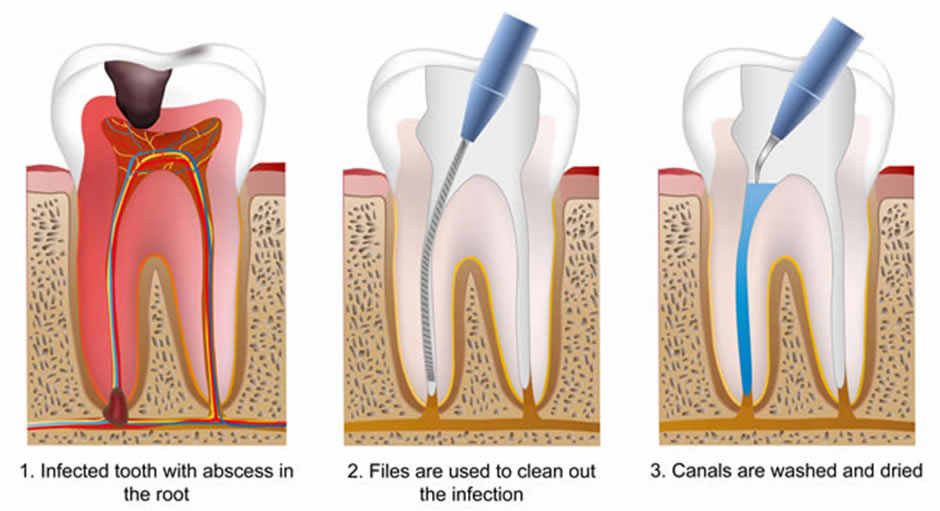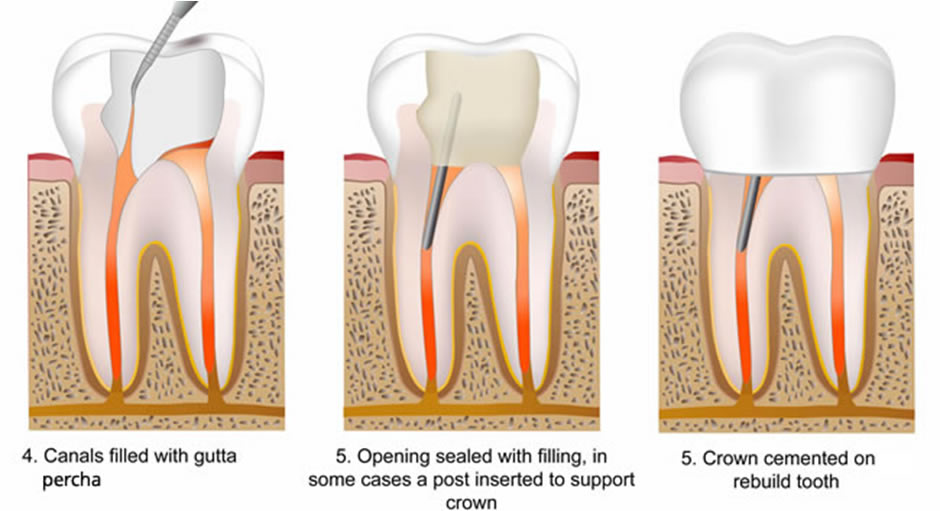A root canal treatment becomes necessary when the nerve supply to the tooth has become infected via decay or trauma. Your tooth may darken in colour (meaning the nerve has died) yet you may not experience any pain initially.
Once we have identified this, we can start on a root canal treatment, a highly specialised process which may require several visits.
The main aim of the procedure is to remove any signs of infection from the root canal, which is then thoroughly cleaned and filled to prevent further infection.
Aftercare and advice
After these steps are taken – and the process can sometimes be completed in one sitting – your tooth may darken slightly, although we have treatments which can prevent this.
Statistically, root treated teeth are more likely to break due to the process weakening the remaining tooth. To counter this we can provide you with a crown which will reinforce the structure of your tooth and see you leaving our practice with perfectly healthy and aesthetically pleasing pearly whites.
Overview
Root canal treatment (dentists refer to this as endodontics) is a dental procedure used to treat infection at the centre of a tooth (the root canal system).
The infection is caused by bacteria that live in the mouth and invade the tooth. This can happen after:
- tooth decay
- leaky fillings
- damage to teeth as a result of trauma, such as a fall
Tooth structure
A tooth is made up of two parts. The crown is the top part of the tooth that’s visible in the mouth. The root extends into the bone of the jaw, anchoring the tooth in position.
Teeth also consist of:
- enamel – the hard outer coating
- dentine – a softer material that supports the enamel and forms most of the tooth
- cementum – a hard material that coats the root’s surface
- dental pulp – the soft tissue at the centre of the tooth
The root canal system contains the dental pulp and extends from the crown of the tooth to the end of the root. A single tooth can have more than one root canal.
When root canal treatment is needed
Root canal treatment is only required when dental X-rays show that the pulp has been damaged by a bacterial infection. The pulp will begin to die if it’s infected by bacteria, allowing the bacteria to then multiply and spread.
The symptoms of a pulp infection include:
- pain when eating or drinking hot or cold food and drink
- pain when biting or chewing
- a loose tooth
As the infection progresses, these symptoms often disappear as the pulp dies. Your tooth then appears to have healed, but the infection has in fact spread through the root canal system.
Further symptoms eventually occur, such as:
- pain when biting or chewing returning
- swelling of the gum near the affected tooth
- pus oozing from the affected tooth
- facial swelling
- the tooth becoming a darker colour
It’s important to see your dentist if you develop toothache. If your tooth is infected, the pulp can’t heal by itself.
Leaving the infected tooth in your mouth may make it worse. There may also be less chance of the root canal treatment working if the infection within your tooth becomes established.
Antibiotics – medication to treat bacterial infections – aren’t effective in treating root canal infections.
How root canal treatment is performed
To treat the infection in the root canal, the bacteria need to be removed. This can be done by either:
- removing the bacteria from the root canal system (root canal treatment)
- removing the tooth (extraction)
However, removing the tooth isn’t usually recommended as it’s better to keep as many of your natural teeth as possible.

After the bacteria have been removed, the root canal will be filled and the tooth sealed with a filling or crown. In most cases the inflamed tissue near the tooth will heal naturally.
Before having root canal treatment, you’ll usually be given a local anaesthetic. This means the procedure shouldn’t be painful and should be no more unpleasant than having a filling.

Root canal treatment is usually successful. In about 9 out of 10 cases a tooth can survive for up to 10 years after root canal treatment.
Recovering from root canal treatment
It’s important to look after your teeth when recovering from root canal treatment. You should avoid biting on hard foods until all of your treatment is complete.
After your final treatment, your restored tooth shouldn’t be painful, although it may feel sensitive for a few days.
Over-the-counter painkillers, such as paracetamol or ibuprofen, can be used to relieve any discomfort. Return to your dentist if you continue to experience pain or swelling after using painkillers.
In most cases it’s possible to prevent the need for further root canal treatment by:
- maintaining good oral hygiene
- not consuming too much sugary food
- giving up smoking if you smoke
“What a great experience I had today with these guys. Due to the awful weather I planned to walk to Port Glasgow from Greenock as my toothache was bad. They then messaged me to say the dentists husband would pick me up. Unbelievable generosity! Was quite anxious as had a bad experience years ago with another dentist and hadn’t been in a long time. Was instantly put at ease by the kind staff. Even gave me a lift home again. Highly, highly recommend Belhaven. Amazing!”
Gary Hood
Please call us on 01475 741 186 or click here to book an appointment, or click here for our services.

Contact Us
Opening Times
| Monday | 0830 – 1830 |
| Tuesday | 0830 – 1830 |
| Wednesday | 0830 – 1830 |
| Thursday | 0830 – 1830 |
| Friday | 0830 – 1645 |

